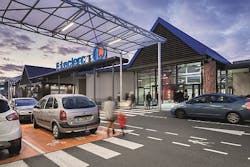Lighting-based Bluetooth customer engagement system triggers sales jump at French store
It's still early days at the E.Leclerc hypermarket, but the Zumtobel system is off to a good start. Not everyone's interested, though.
A giant E.Leclerc retail store in southwestern France has reported that revenue rose between 34% and 42% from certain customers who over the last few months wirelessly connected their smartphones to Bluetooth-equipped ceiling lights delivering discounts and information.
Interested in articles & announcements on lighting-based indoor positioning applications?
Lighting vendor Zumtobel, which switched on the technology in 800 LED luminaires in December after first announcing it a year ago, said 771 people used an E.Leclerc app that gave them access to the Internet of Things (IoT) lighting system at the 75,000-ft2 E.Leclerc hypermarket in Langon.
Zumtobel outfitted the luminaires with Bluetooth beacons for indoor positioning to transmit information such as product offers and location to customers' phones. The customers had agreed to tie the app into their E.Leclerc loyalty schemes, so E.Leclerc can tailor specific messages to individual interests and buying habits. Customers can also request missing products when they're in the store.
One group of customers that E.Leclerc had already categorized as high turnover spent 34% more than in the previous year (presumably in the same period), Zumtobel said. Another group, of typically less-frequent buyers, spent 42% more. The 771 users included a third group, consisting of employees. In a joint announcement, neither E.Leclerc nor Zumtobel's Zumtobel Group Services (ZGS) division released results on employees’ use of the system, which Zumtobel refers to as the Internet of Light.
The LED luminaires inside the E.Leclerc hypermarket give you all the more reason not to leave your phone in the car.
One thing that the trial also revealed is that many people seem uninterested in engaging with such systems. E.Leclerc notified 2260 customers about the opportunity to tap into the system. Of those, 1119 — just under half — downloaded the app. Of the 1119 who fetched it, 771 customers actually used it.
E.Leclerc was pleased with the results, not just for the revenue boost but also for the overall improvement in customer engagement, including the indoor positioning system's ability to gather insights on individual customer behavior.
“With the expertise of ZGS and connected lighting, we were able to design a modern and interactive shopping center in Langon — a place where our customers can experience a completely new way of shopping,” said Alain Lafforgue, the store's CEO. “Thanks to virtual customer interaction, we are getting to know our customers and learning more about their individual wishes. With this knowledge, we will be able to increase satisfaction levels and thereby generate greater customer loyalty.”
As LEDs Magazine noted when we first wrote about the trial last year, E.Leclerc chose Bluetooth technology, which uses the radio spectrum, over another technology called visible light communication (VLC), which sends data to phones via LED light waves.
While VLC is more accurate than Bluetooth in navigating customers to a particular product, E.Leclerc considered Bluetooth to be accurate enough, especially since navigation was less important in the E.Leclerc project in which many customers generally know the store's layout.
One advantage that Bluetooth has over VLC is that users can keep their phones in their pocket, whereas VLC requires the user to keep the phone pointed at ceiling lights.
The use of Bluetooth, however, raises the question of why retailers such as E.Leclerc should turn to lighting companies rather than IT and networking firms for indoor positioning and customer engagement systems.
Proponents of lighting-based Bluetooth note that the lighting infrastructure is pervasive and thus provides a ready-made and unobtrusive place to put beacons. On top of that, the beacons can draw from the same power supply that delivers electricity to luminaires, thus avoiding the need to use beacons powered by batteries, which can be problematic.
Zumtobel is planning an open discussion about the E.Leclerc Bluetooth project tomorrow at the Light+Building exhibition in Frankfurt. LEDs editor Maury Wright is prowling the show floor. Watch for updates from him.
MARK HALPER is a contributing editor for LEDs Magazine, and an energy, technology, and business journalist ([email protected]).

Mark Halper | Contributing Editor, LEDs Magazine, and Business/Energy/Technology Journalist
Mark Halper is a freelance business, technology, and science journalist who covers everything from media moguls to subatomic particles. Halper has written from locations around the world for TIME Magazine, Fortune, Forbes, the New York Times, the Financial Times, the Guardian, CBS, Wired, and many others. A US citizen living in Britain, he cut his journalism teeth cutting and pasting copy for an English-language daily newspaper in Mexico City. Halper has a BA in history from Cornell University.





